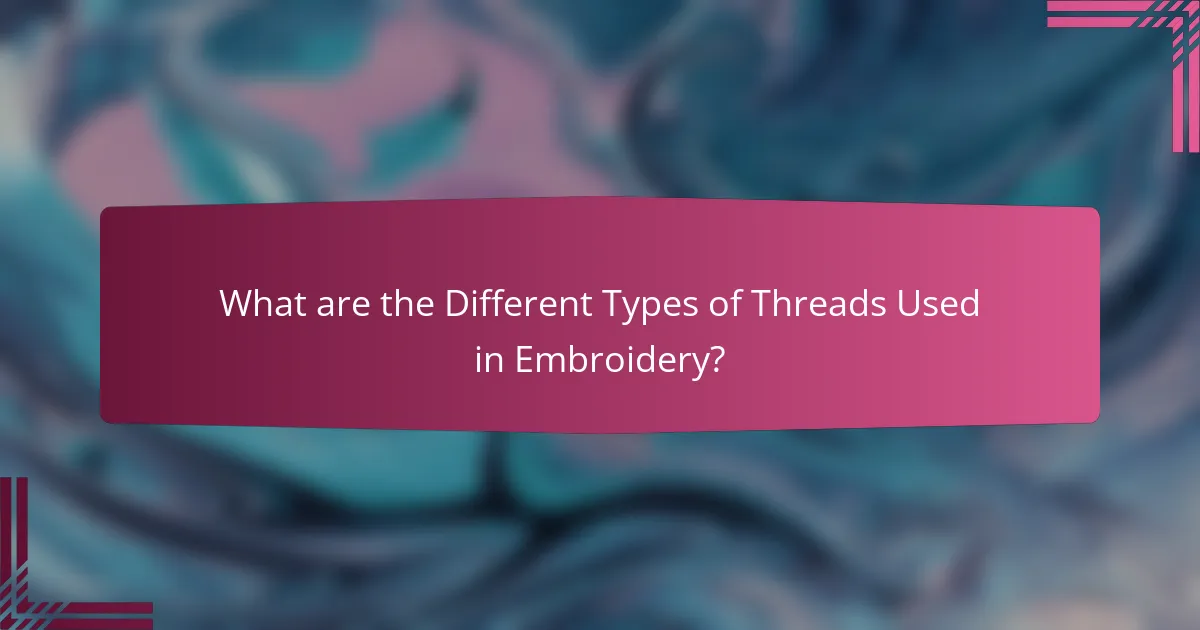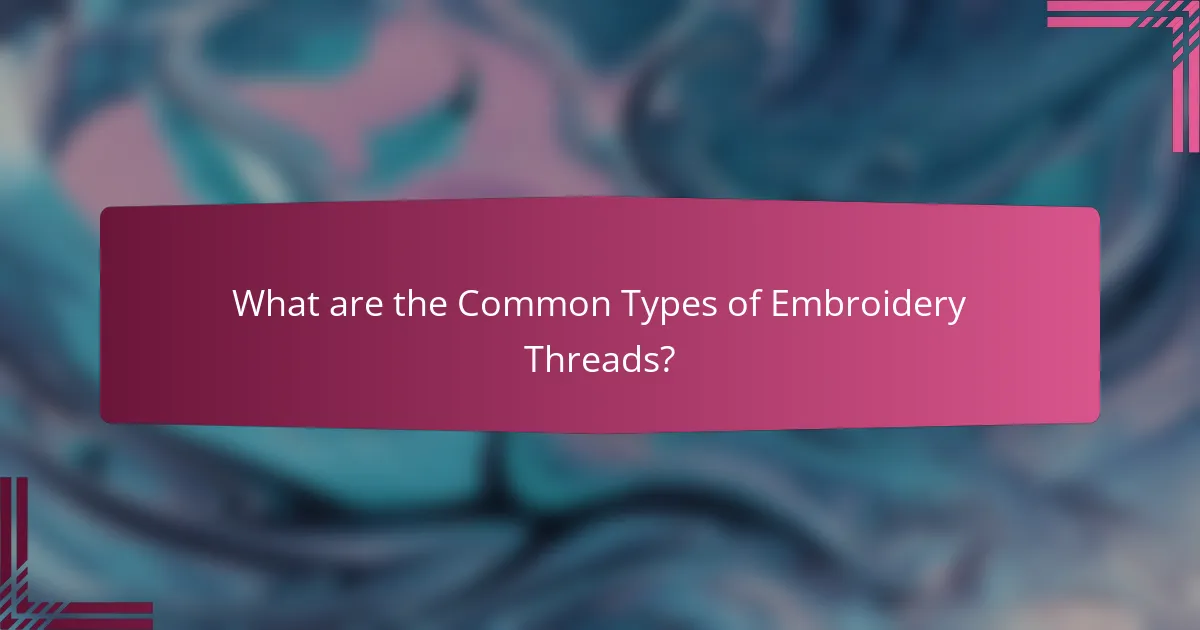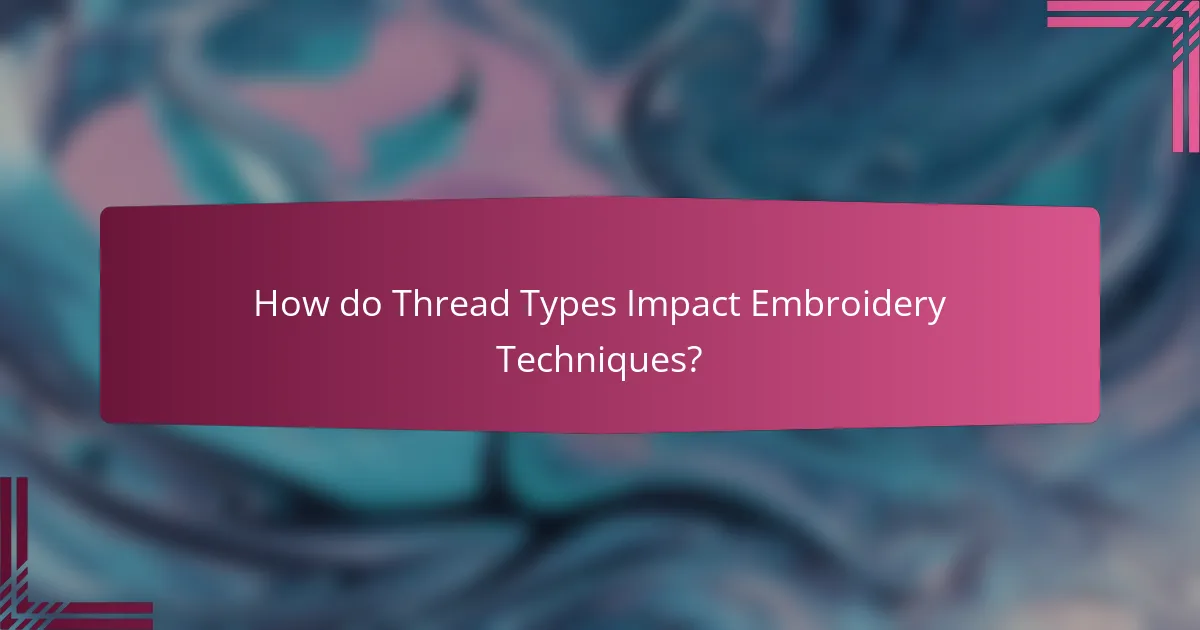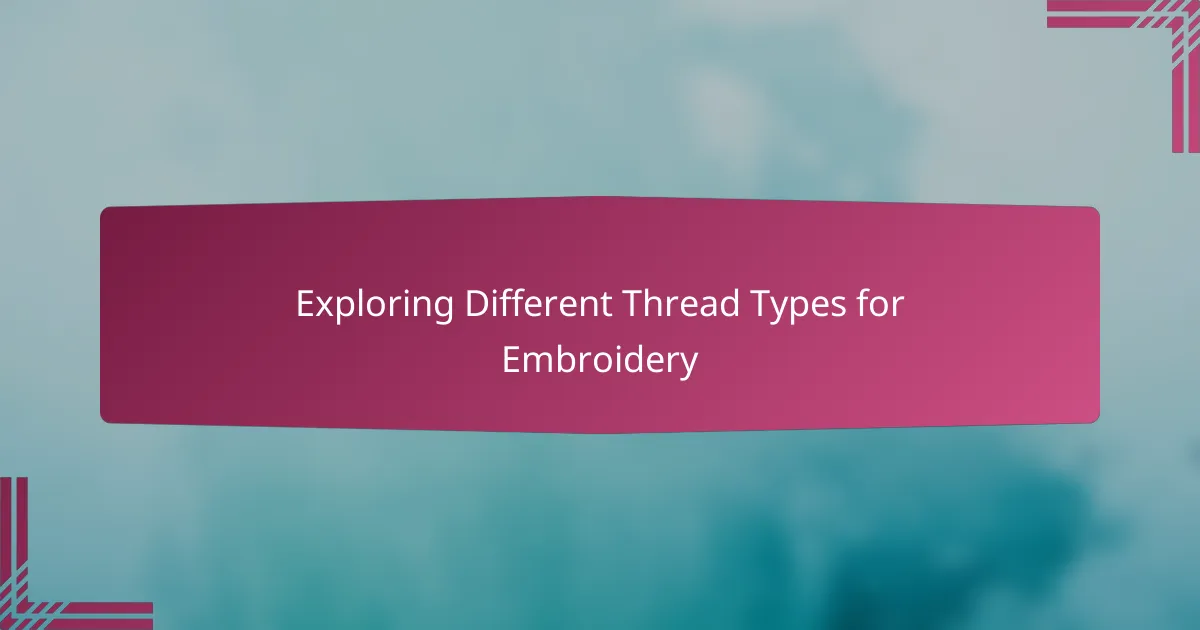
What are the Different Types of Threads Used in Embroidery?
The different types of threads used in embroidery include cotton, polyester, rayon, silk, and metallic threads. Cotton threads are popular for their versatility and ease of use. Polyester threads are known for their strength and colorfastness. Rayon threads offer a shiny finish and smooth texture. Silk threads provide a luxurious appearance and are often used for high-end projects. Metallic threads add sparkle and dimension to designs. Each type of thread has unique properties that suit various embroidery techniques and styles.
How do these thread types vary in composition and texture?
Thread types vary significantly in composition and texture. Common embroidery threads include cotton, polyester, and rayon. Cotton threads are natural fibers known for their softness and matte finish. Polyester threads are synthetic and offer strength and sheen. Rayon threads, also synthetic, provide a silky texture and vibrant colors. Each type has distinct attributes affecting their performance. For instance, cotton is absorbent and ideal for natural fabrics. Polyester resists fading and is suitable for various applications. Rayon is often chosen for its luster and smooth finish, enhancing the visual appeal of embroidery. The choice of thread impacts the final look and durability of the embroidery project.
What materials are commonly used in embroidery threads?
Embroidery threads are commonly made from materials such as cotton, polyester, silk, and rayon. Cotton threads are popular for their natural fiber and versatility. Polyester threads are known for their durability and resistance to fading. Silk threads provide a luxurious finish and a natural sheen. Rayon threads are often chosen for their vibrant colors and smooth texture. Each material offers unique properties suitable for different embroidery techniques and projects.
How does the texture of thread affect embroidery results?
The texture of thread significantly influences embroidery results. Different textures can affect the appearance and feel of the finished design. For instance, smooth threads create clean lines and sharp details. Textured threads can add dimension and visual interest. Additionally, the thickness of the thread impacts coverage and the overall richness of color. A thicker thread may obscure fabric patterns, while a finer thread offers more subtlety. Research indicates that thread texture also affects stitch tension and fabric interaction. This can lead to variations in durability and wear over time. Thus, selecting the right thread texture is crucial for achieving desired embroidery outcomes.
What factors should be considered when choosing embroidery thread?
When choosing embroidery thread, consider the thread type, material, and thickness. Different thread types include cotton, polyester, and rayon, each offering unique qualities. Cotton thread is durable and suitable for various fabrics. Polyester thread is strong and colorfast, making it ideal for machine embroidery. Rayon thread provides a shiny finish but may not be as durable.
Additionally, thread thickness affects the final appearance. Thicker threads create bolder designs, while thinner threads offer delicate detailing. Evaluate the fabric being used, as some threads work better with specific materials. Lastly, consider the intended use of the embroidered item, as this influences the thread’s durability and appearance.
How does thread weight influence embroidery design?
Thread weight significantly influences embroidery design by affecting the appearance and texture of the finished work. Heavier thread creates bolder, more defined stitches. It can enhance visibility and add dimension to designs. Conversely, lighter thread produces finer, more delicate details. This allows for intricate patterns and subtle shading effects. The choice of thread weight also impacts the fabric used. Heavier threads may require sturdier fabrics to support their weight. In contrast, lighter threads are suitable for more delicate materials. Overall, selecting the appropriate thread weight is crucial for achieving the desired aesthetic in embroidery design.
What role does thread sheen play in the overall appearance?
Thread sheen significantly affects the overall appearance of embroidery. It influences the visual impact and texture of the finished piece. High-sheen threads reflect light, creating a vibrant and eye-catching effect. In contrast, low-sheen threads offer a more muted and subtle look. The choice of sheen can enhance design elements, making them stand out or blend in as desired. For example, satin threads have a glossy finish, ideal for luxurious designs. Conversely, matte threads provide a classic, understated aesthetic. Thus, the sheen of thread plays a crucial role in achieving the intended design outcome in embroidery.

What are the Common Types of Embroidery Threads?
The common types of embroidery threads include cotton, polyester, rayon, and silk. Cotton threads are widely used for their durability and versatility. Polyester threads offer strength and resistance to fading. Rayon threads are known for their sheen and vibrant colors. Silk threads provide a luxurious finish and are often used for high-end projects. Each type has specific uses depending on the fabric and desired effect in embroidery.
What is the difference between cotton and polyester threads?
Cotton threads are made from natural fibers, while polyester threads are synthetic. Cotton is soft, breathable, and has a natural sheen. Polyester is stronger, more durable, and resistant to fading and shrinking. Cotton threads absorb moisture, making them suitable for fabrics that require softness. Polyester threads dry quickly and are ideal for outdoor use. Cotton can be more prone to fraying, while polyester is less likely to tangle. The choice between them depends on the desired finish and fabric type.
What are the advantages of using cotton threads?
Cotton threads offer several advantages for embroidery. They are soft and easy to work with, making them ideal for delicate fabrics. Cotton threads also have a natural sheen, enhancing the visual appeal of embroidery designs. Additionally, they are breathable and absorbent, which helps maintain the quality of the fabric. Cotton is durable and can withstand frequent washing without losing its integrity. Furthermore, these threads come in various colors, allowing for creative expression in embroidery projects. Lastly, cotton is a sustainable material, making it an eco-friendly choice for crafters.
In what scenarios is polyester the preferred choice?
Polyester is the preferred choice in scenarios requiring durability and colorfastness. It resists fading and maintains its vibrant hues over time. Polyester threads are also resistant to moisture, making them suitable for outdoor applications. Additionally, they have a high tensile strength, which reduces the risk of breakage during embroidery. Polyester is often chosen for projects that demand high performance, such as sportswear and uniforms. Its ability to withstand frequent washing without losing quality further supports its use in these contexts. Furthermore, polyester threads are versatile and can be used on various fabrics, enhancing their appeal for diverse embroidery projects.
What specialty threads are available for unique effects?
Specialty threads for unique effects include metallic threads, glow-in-the-dark threads, and variegated threads. Metallic threads add shine and dimension to embroidery projects. They are often used for decorative stitching and embellishments. Glow-in-the-dark threads create a luminous effect in low light conditions. These threads are popular for fun and whimsical designs. Variegated threads feature multiple colors in a single strand. They provide a gradient effect in stitching, enhancing visual interest. Other specialty threads include reflective threads, which enhance visibility, and textured threads, which add depth. Each type serves specific creative purposes in embroidery.
How do metallic threads enhance embroidery designs?
Metallic threads enhance embroidery designs by adding shine and texture. Their reflective properties create a striking visual effect that attracts attention. This characteristic makes them ideal for decorative elements in various projects. Metallic threads can elevate the overall aesthetic of designs, making them more luxurious and eye-catching. They are often used in traditional and contemporary embroidery styles. The use of metallic threads can also emphasize specific motifs or details. Their versatility allows for a wide range of applications, from intricate patterns to bold statements. Incorporating metallic threads can significantly impact the final appearance of an embroidered piece.
What are the benefits of using variegated threads?
Variegated threads offer unique visual effects in embroidery. They create a gradient of colors, enhancing the depth and dimension of designs. This type of thread can simplify the color selection process. It reduces the need for multiple thread changes during a project. Variegated threads also add interest to solid color areas. They can make simple patterns appear more complex and intricate. Additionally, they are available in various fiber types, including cotton and polyester. Their versatility allows for use in different embroidery techniques.

How do Thread Types Impact Embroidery Techniques?
Thread types significantly impact embroidery techniques by affecting stitch quality, appearance, and durability. Different materials, such as cotton, polyester, and rayon, yield varying results. Cotton threads provide a matte finish and are ideal for natural fabrics. Polyester threads offer durability and colorfastness, making them suitable for items exposed to wear. Rayon threads are known for their sheen and vibrant colors, enhancing decorative designs. The thickness of the thread also influences stitch density and texture. Thicker threads create bold outlines, while thinner threads allow for intricate details. Ultimately, selecting the appropriate thread type is crucial for achieving desired embroidery effects.
What techniques are best suited for different thread types?
Different thread types require specific techniques for optimal results. For cotton threads, techniques like straight stitching and satin stitching are effective due to their versatility and smooth finish. Polyester threads perform well with techniques like zigzag stitching and machine embroidery, as they offer durability and elasticity. Rayon threads are best suited for decorative techniques such as free-motion embroidery and appliqué, as they provide a vibrant sheen. Metallic threads require careful handling with techniques like slow stitching and using a needle designed for metallic threads to prevent breakage. Each thread type has unique properties that influence the choice of technique, ensuring the best quality in embroidery projects.
How does thread type affect stitch quality and durability?
Thread type significantly impacts stitch quality and durability. Different materials and constructions of threads affect how they perform during stitching. For instance, polyester threads are known for their strength and resistance to fading. Cotton threads, while softer, may not hold up as well under stress or exposure to elements.
The thickness of the thread also plays a crucial role. Thicker threads create bolder stitches but may lead to tension issues. Conversely, thinner threads provide finer detail but can break more easily.
Additionally, the twist of the thread influences stitch integrity. A tightly twisted thread can enhance durability and reduce fraying. In contrast, loosely twisted threads may lead to uneven stitches and lower quality outcomes.
Research indicates that using the appropriate thread type for specific fabrics enhances overall project longevity. For example, using a thread designed for stretch fabrics can prevent seam failure. Thus, selecting the right thread type is essential for achieving optimal stitch quality and durability in embroidery projects.
What are the implications of thread choice on machine embroidery?
Thread choice significantly impacts the quality and appearance of machine embroidery. Different thread types can affect the texture, sheen, and durability of the finished design. For instance, polyester threads are known for their strength and colorfastness, making them ideal for durable applications. Cotton threads, while softer and more natural, may not hold up as well under stress.
The thickness of the thread also influences the stitch density and overall design clarity. Thicker threads can create bold, prominent designs but may require adjustments in machine settings. Conversely, finer threads allow for intricate details but can be more challenging to work with.
Additionally, thread choice affects the fabric compatibility. Some threads may cause puckering or tension issues on certain fabrics. Understanding these implications helps embroiderers select the appropriate thread for their specific project needs.
How can one troubleshoot common issues with embroidery threads?
To troubleshoot common issues with embroidery threads, first identify the specific problem, such as thread breakage or uneven stitching. For thread breakage, check the tension settings on the machine. Adjusting the tension can often resolve this issue. Ensure that the thread is properly threaded through the machine. Misthreading can lead to breakage.
If the thread is fraying, inspect the needle for damage. A damaged needle can cause thread wear. Using the correct needle type for the thread is crucial. Different threads require specific needle sizes and types.
For uneven stitching, verify that the thread is wound evenly on the spool. An uneven spool can lead to inconsistent tension. Additionally, check the bobbin for proper winding and placement. An incorrectly placed bobbin can affect stitch quality.
Lastly, ensure that the thread is compatible with the fabric being used. Some threads perform better on certain fabrics. By addressing these common issues, you can improve your embroidery results.
What are the most frequent problems encountered with thread types?
Frequent problems encountered with thread types include fraying, breaking, and tangling. Fraying occurs due to poor quality or incorrect tension settings. Breaking often results from using incompatible needle sizes or excessive tension. Tangling typically happens when threads are not properly wound on spools or when they are too old. Additionally, color bleeding can occur with certain threads during washing. These issues can affect the overall quality of embroidery projects.
How can proper thread selection prevent common embroidery issues?
Proper thread selection can significantly prevent common embroidery issues. Choosing the right thread type ensures compatibility with the fabric and machine. For instance, using polyester thread can reduce breakage on high-speed machines. Cotton thread is ideal for natural fabrics, preventing puckering. Thread weight affects stitch quality; lighter threads may cause skipped stitches. The correct color matching can also prevent bleeding and fading. Additionally, selecting threads with appropriate tensile strength minimizes fraying and snagging. This careful consideration of thread attributes leads to higher quality embroidery outcomes.
What tips can enhance the use of various thread types in embroidery?
Use the right needle for each thread type to avoid damage. Choose a needle with a larger eye for thicker threads. Adjust the tension settings on your sewing machine based on the thread thickness. Use the appropriate stitch length for different threads to ensure even results. Test your thread choice on a scrap fabric before starting the main project. Keep threads organized to prevent tangling and confusion. Store threads in a cool, dry place to maintain their quality. Regularly clean your machine to avoid thread build-up and ensure smooth operation.
The main entity of the article is embroidery thread, which encompasses various types including cotton, polyester, rayon, silk, and metallic threads. The article provides an in-depth examination of these thread types, detailing their composition, texture, and unique properties that influence embroidery techniques and outcomes. Key factors such as thread weight, sheen, and material suitability are discussed, along with troubleshooting common issues related to thread choice. Additionally, the article highlights specialty threads for unique effects and offers practical tips for enhancing embroidery projects through proper thread selection and usage.
